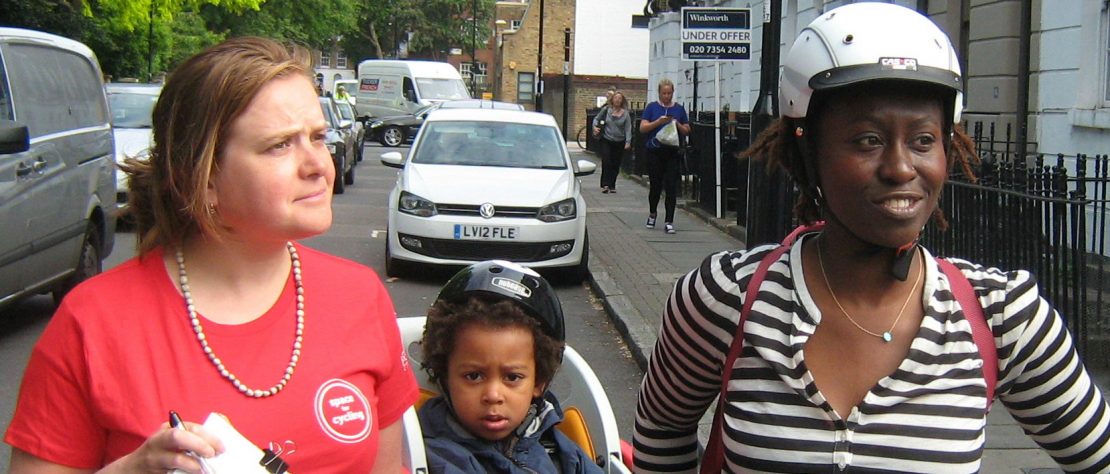Dear Councillor Webbe,
Thank you for the feasibility study for Quietway 10 which you provided to ICAG in March. We look forward to receiving the companion report which analyses our proposal in full. The study’s proposed options and the Council’s plans for the route are extremely disappointing. The Council has a unique opportunity to use £800k of TfL money to reduce motor traffic, pollution and car-dependency in Islington by removing through motor traffic from a few streets. Instead, the Council intends to ignore the root problem: there is too much motor traffic on this route for it to be considered a Quietway. Because of this, we cannot support the current plans.
In the recently-published Human Streets review of the Mayor’s Vision for Cycling, the Greater London Authority states:
Quietways are supposed to be direct routes running on low-traffic back streets. They are meant to include filtering (bollards or other blockages) to reduce motor vehicle rat-running where necessary; full segregation wherever a route has to use a busy main road; and safe, direct crossings where the route has to cross a busy junction, road or gyratory.
This gets to the heart of the matter. This route needs traffic filters and junction segregation, or it will not be a Quietway.
TfL’s Cycle Level of Service (CLoS) assessment measures the quality of cycling provision on roads, either current or proposed. One requirement imposed by this tool is that roads and junctions where bicycles are unseparated must see no more than 1000 PCU (Passenger Car Units) per hour at the peak, (figure 2.3 of London Cycling Design Standards). Any more, and the street or junction fails the test. A cycle scheme which fails the CLoS assessment cannot receive TfL Quietway funding.*
At least three unprotected junctions on the Quietway 10 route see more than 1000 PCU per hour at the peak today. At these junctions, the report proposes neither traffic reduction nor cycle segregation**.
- Penton Street and Donegal Street
- Penton Street and Tolpuddle Street
- Drayton Park and Martineau Road
These three critical CLoS failures must be addressed before the project can progress.
When the Council proposed Quietway 2 with no filtering, ICAG objected in private to both officers and councillors. We pointed out a few problems with the route publicly, but stopped short of rejecting the route outright. Instead, we made it clear at liaison meetings that to receive our support, future Quietways must actually be made “quiet”. The data collected show that the Quietway 10 route is not quiet today. The feasibility report specifically recommends reducing traffic by installing at least one traffic filter, at the dangerous junction of Gillespie Road and Drayton Park. And yet the Council is still refusing to consider any traffic filters at all on the whole 3.5-mile route.
Determining if a section of road is “quiet” is straightforward. CLoS rates a route “good” if it has fewer than 500 PCU at peak hours where people cycling are mixing with motor traffic. The junction of Thornhill Road and Bewdley Street sees over 600 PCU in the peak. Another useful metric is London Cycling Campaign policy, based on international best practice, which requires no more than 2,000 vehicles per day on streets without segregated cycle infrastructure. The report identifies 3,300 vehicles passing through the top end of Thornhill Road in just 12 hours of the day. This far exceeds the LCC maximum. Volumes are even higher on Gillespie Road, at around 5,000 vehicles per day.
The traffic data used to reject the (poorly-placed) filters on Drayton Park and Offord Road in the study comprise only motor vehicle counts. This does not take account of where the vehicles have come from, and thus it can’t distinguish between rat-running motor traffic (which will likely end up on parallel routes, either nearby or many miles away) and local motor traffic (which will partially evaporate as habits change). In fact, the report assumes no traffic evaporation at all. But motor traffic does evaporate, as has been proven by studies for TfL (Cairns et al) and the European Commission, among others.*** This means the estimated motor traffic displacement is far greater than it will be in reality. Not accounting for motor traffic evaporation through mode and time shifting is widely recognised to be the main failing of traffic models, and it’s why we have suggested installing automatic traffic counters, adding temporary area-wide filters, and creating a report after a six-month trial to see how traffic has actually adapted. This approach is cheaper and more reliable than traffic models, and it’s the approach currently being used in locations across London including neighbouring Harringay (Wightman Road).
The report asserts that 1.5m cycle tracks are an adequate option on stretches of Penton Street and Drayton Park. There are far too many people using these streets on bicycles today for this to be sufficient. (Over 800 per hour on Penton Street at the peak.) Tracks of only 1.5m do not provide enough space for cyclists to pass one another. This is why the recommended width of cycle lanes in the UK is 2m.**** Consequently, they also provide only half as much capacity as tracks which are just 50cm wider. We can’t support infrastructure which is inadequate for today’s needs, much less tomorrow’s.
Because Islington Council implemented very unambitious plans for Quietway 2, we created the Liveable Islington campaign with Living Streets and Better Archway Forum to promote the “human streets” which the Quietway programme envisions. The campaign has emphasised the benefits that reducing through traffic will bring to neighbourhoods, in addition to enabling all-ages cycling. We know that there is strong support for our proposal because we have so far collected 2,400 signatures in favour of a six-month trial of our area-wide filtering scheme.
In your email of March 8th, you say ‘the Council has received letters from residents’ associations and individuals along the route expressing their concerns about the possibility of road closures in their area’. First of all, we are proposing traffic filters, not road closures. Cars and delivery vans will still be able to access every residence and motorcycles, bicycles and pedestrians will be able to use the roads exactly as before. No road will be “closed”. On the letters you have received, we urge you to assess the legitimacy of the concerns and to seek the best evidence available, not to compromise the scheme completely in its initial design. There are many people who are disadvantaged by current traffic patterns—we heard from them in the course of gathering signatures for the petition. Residents of Gillespie Road, for example, have taken video of opposing columns of car traffic at a standstill and unable to make their way through the one-lane street. By maintaining the status quo, you guarantee that those being harmed by rat-running traffic today will continue to suffer. Traffic will be dispersed to a number of other roads if Quietway 10 is done right. But by pushing ahead with a scheme which displaces no motor traffic at all, you would condemn residents who live on the route to air which breaches EU pollution limits and motor traffic levels which harm the quality of life. You would ensure that Islington will not benefit from motor traffic evaporation. You would also guarantee that the conversation about how to deal with excessive motor traffic, and about who benefits and who suffers from traffic patterns, would not be had in public.
We look forward to working with your officers and TfL to deliver a Quietway 10 which passes CLoS with a high score, reduces pollution in Islington, and creates streets which enable people of all ages and abilities to cycle in comfort and safety.
Sincerely,
Nick Kocharhook
for Islington Cyclists
CC John Futcher, Senior Strategy and Planning Manager – Cycling, TfL
CC Toby Jones, Project Assistant, Sustrans
[*] London Cycle Design Guide section 1.1.2: “The requirements for cycling infrastructure proposals delivered through the Mayor’s Vision for Cycling, are that they should:
2b. Meet the minimum standard expressed in the Cycling Level of Service (CLoS) assessment, and any further programme- or project-specific requirements”
London Cycle Design Guide Section 2.2.3: “Certain factors also have ‘critical’ scores, which describe circumstances that should be a cause for particular concern. Clients and designers must address these as a priority, even if only to ‘lift’ them to a zero score as an interim measure – a scheme that registers as ‘critical’ on any one indicator has not met the required standard.”
[**] Item 2.15.8 on the southern feasibility study says: “Reduce the carriageway width to provide a minimum 4m segregated footway / cycleway with cyclists adjacent to the kerb line to keep frontage free between Tolpuddle Street and Donegal Street on both sides of the street. Provide Copenhagen style crossings at all junctions.” What this means is very unclear, but it sounds like it’s proposing to put cycle tracks of an unspecified width at pavement level for these two blocks. Given that the cycle volume here (800+/hour) requires 2.4m tracks, this would leave only 1.6m for pedestrians. This seems likely to create conflict between people on bikes and pedestrians, and we would want to hear a compelling case for why this was the best option available.
A “Copenhagen crossing” is also called a “continuous pavement,” but we don’t believe the report is actually suggesting continuous pavements across all arms of all 3 junctions. Instead, we believe it is proposing Danish-style junctions, where turning motor traffic first merges into the cycle track. Regardless, neither treatment is segregated, and so they don’t meet CLoS requirements for high-traffic junctions. It’s a particularly poor idea at Tolpuddle Street, where many buses turn across the main cycle flow every hour.
The junction of Penton Street and Pentonville Road also exceeds the 1000 PCU requirement, and by much more than the other three. The report doesn’t provide options for this junction, so we cannot evaluate them. However, we point out that our preferred option (as communicated to Paul Taylor in November) is to reduce the Penton Street carriageway to a single lane of northbound traffic, leaving room for parking and adequate, unobstructed cycle tracks. This would also remove the left hook southbound.
[***] See Wikipedia for a good overview of the research showing that motor traffic evaporation occurs when road capacity is reduced. <https://en.wikipedia.org/wiki/Disappearing_traffic>
[****] https://www.camcycle.org.uk/resources/cyclelanewidths/


This is all beyond Cllr Webbe’s understanding